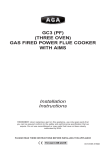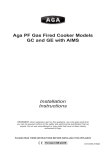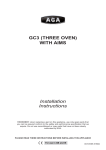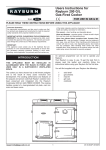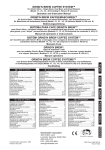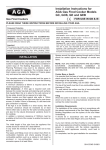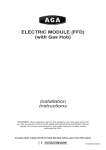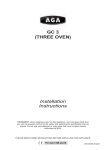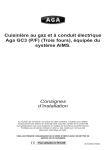Download AGA GC 3 Technical data
Transcript
GC 3 (PF) (THREE OVEN) GAS FIRED POWER FLUE COOKER Installation Instructions REMEMBER: when replacing a part on this appliance, use only spare parts that you can be assured conform to the safety and performance specification that we require. Do not use reconditioned or copy parts that have not been clearly authorised by AGA. PLEASE READ THESE INSTRUCTIONS BEFORE INSTALLING THIS APPLIANCE For use in GB and IE 09/10 EINS 515476 CONTENTS SECTION PAGE HEALTH & SAFETY 3 INSTALLATION 4 LOCATION 4 TECHNICAL DATA 5-7 FLUE SYSTEM 8 - 11 AIR SUPPLY 12 INSTALLATION PIPES 12 BAKING OVEN BAFFLE PLATE 12 ELECTRICAL 12 COMMISSIONING - USING CONTROL KNOB WITH NUMBERED GRAPHICS 13 - 15 COMMISSIONING - USING CONTROL KNOB WITH GREEN BAND GRAPHICS 16 - 18 2 HEALTH & SAFETY Consumer Protection As responsible manufacturers we take great care to make sure that our products are designed and constructed to meet the required safety standards, when properly used and installed. IMPORTANT NOTICE: PLEASE READ THE ACCOMPANYING WARRANTY. Any alteration that is not approved by AGA could invalidate the approval of the appliance, operation of the warranty and could affect your statutory rights. Important This appliance may contain some of the materials that are indicated. It is the Users/Installers responsibility to ensure that the necessary personal protective clothing is worn when handling, where applicable, the pertinent parts that contain any of the listed materials that could be interpreted as being injurious to health and safety, see below for information. Firebricks, Fuel beds, Artificial Fuels - when handling use disposable gloves. Fire Cement - when handling use disposable gloves. Glues and Sealants - exercise caution - if these are still in liquid form use face mask and disposable gloves. Glass Yarn, Mineral Wool, Insulation Pads, Ceramic Fibre, Kerosene Oil - may be harmful if inhaled, may be irritating to skin, eyes, nose and throat. When handling avoid inhaling and contact with skin or eyes. Use disposable gloves, face-masks and eye protection. After handling wash hands and other exposed parts. When disposing of the product, reduce dust with water spray, ensure that parts are securely wrapped. 3 INSTALLATION With specific exceptions, the installing of any type of AGA cooker is subject to the respective directions contained in current issue of the Building Regulations. In addition, Planning Permission may need to be obtained, which should be applied for separately. The complete range of AGA cookers are suitable for Natural or Propane gases only and cannot be used on any other gas. (IMPORTANT: See data plate which is situated on burner housing panel behind top left door). The complete cooker is floor-mounted and the space in which the appliance is to be fitted must have the following minimum dimensions:A minimum clearance of 60mm is required above the raised insulating cover handle. Side Clearances: A 3mm gap is required each side between the cooker top plate and adjoining work surfaces that may be fitted, this is to allow for the safe removal of the top plate should this be required at a later date. Where cookers are fitted against side walls a 116mm clearance is required at the right hand side for oven doors access. (A further 116mm is necessary, if a left hand side gas connection is required). If the Aga is to be installed in a brick recess, then the minimum clearance should be increased by at least 10mm on either side, to allow for the walls not being square and also for the natural dimensional variations found in the castings. In addition, a minimum clearance of 1000mm must be available at the front of the cooker to enable it to be serviced. The wall behind the cooker must be of non-combustible material for a minimum thickness of 25mm. NOTE: AGA GAS FIRED COOKERS ARE DELIVERED EX-WORKS UNASSEMBLED. ASSEMBLY IS UNDERTAKEN ON SITE BY THE AUTHORISED AGA DISTRIBUTOR. Cooker Base of Hearth it is essential that the base or hearth on which the cooker stands should be level and be capable of supporting the total weight of the cooker. Model GC3 - 477 Kg The top of the hearth must be of non-combustible material thickness of 12mm. Tiling When the cooker is to stand in a recess, or against a wall which is to be tiled, in no circumstances should the tiles overlap the cooker top plate. Installation Requirements The installation of the cooker must be in accordance with the relevant requirements of the Gas Safety Regulations, Building Regulations. It should be in accordance also with any relevant requirements of the Gas Region and Local Authority. In your own interest, and that of safety to comply with the law, all gas appliances should be installed by a competent person, in accordance with the relevant regulations. Failure to install appliances correctly could lead to prosecution. On completion, test the gas installation for tightness. LOCATION The location chosen for the appliance must permit the provision of a satisfactory flue and an adequate air supply. The location must also provide adequate space for servicing and air circulation around the cooker. 4 TECHNICAL DATA - AGA GC3 (POWER FLUE) FIG. 1 DESN 513391B A B C D E F G H J K mm 987 967 851 679 41 1330 756 1125 39 3 L R S 698 116 48 T U V 65 375 595 667 PLEASE NOTE: SIDE CLEARANCE DIMENSION R IS ALSO REQUIRED ON THE LH SIDE FOR THE BAKING OVEN DOOR. COOKER DIMENSIONS When surveying for a cooker installation the actual clearance required for the ‘body’ of the appliance should be increased overall by 10mm beyond the figures quoted below. This allows safe margin to take into account the natural dimensional variations found in major castings. In particular the width across the appliance recess could be critical. GAS CONNECTION GC3 POWER FLUE ONLY 1/4” BSP supply pipe, with 1/4” BSP to 15mm fitting provided. GAS CONNECTION GC3 POWER FLUE WITH MODULE (IF FITTED) See Fig. 1A, and refer to Module Installation Instructions. 5 W TECHNICAL DATA - AGA GC3 (POWER FLUE) WITH MODULE DESN 513392 B FIG. 1A A B C D *** E mm 1598 889 851 679 60 F G H J I* K 967 1330 756 1125 685 116 L 3 M N** O** P 698 1533 800 48 Q R S T 65 375 500 595 960 * GAS SUPPLY PIPE FOR GC3 (PF) WHEN FITTED TO MODULE ** POSITION FOR GAS SUPPLY PIPE TO MODULE *** WHEN ADJACENT TO COMBUSTIBLE MATERIAL COOKER DIMENSIONS When surveying for a cooker installation the actual clearance required for the ‘body’ of the appliance should be increased overall by 10mm beyond the figures quoted below. This allows safe margin to take into account the natural dimensional variations found in major castings. In particular the width across the appliance recess could be critical. 6 U TECHNICAL DATA (CONTINUED) Models GC3 Power Flue GC3 (PF) NATURAL G20 MAXIMUM HEAT INPUT Thermostat Bypass Main Burner Injector Pilot Injector Inlet Pressure Burner Pressure 5kW 110 400 4212 20mbar 10mbar PROPANE G31 5kW (357g/h) 65 170 4209 37mbar 25mbar MAXIMUM HEAT INPUT Thermostat Bypass Main Burner Injector Pilot Injector Inlet Pressure Burner Pressure 7 FLUE SYSTEM SEE FIGS. 2, 3, 4 & 5 The flue system must be installed in accordance with the regulations in force. Products of combustion discharge is by a fan powered flue pipe of 50mm diameter which can reach up to 6 metres in length through a maximum of 6 x 90Þ bends or 9 metres with one bend. Exits from the appliance can be from rear LH or RH sides, from the rear centre or from the underside (See Figs. 4 & 5). The flue pipe should exit through the outside wall fixing plate by 25mm (Fig. 2). Terminal Position The minimum acceptable spacings from the terminal to obstructions and ventilation openings are as shown in Fig. 3. Where the terminal is fitted within 600mm below plastic guttering an aluminium shield 1000mm long should be fitted to the underside and immediately beneath the guttering or eaves. Where the terminal is fitted within 450mm below eaves or painted guttering an aluminium shield 750mm long should be fitted to the underside and immediately beneath the guttering or eaves. Terminal Protection A terminal guard is supplied with the cooker and must be fitted, if flue termination is less than 2 metres above ground level, or subject to damage. When fitted, it must be positioned to provide a minimum of 50mm clearance from any part of the terminal and be central over the terminal. EXTERNAL WALL FIG. 2 DESN 511189 8 Minimum siting dimensions for Flue terminals Position Minimum Spacing mm A Directly below an openable window, air vent, or an other ventilation opening 300 B Below gutter, drain/soil pipe 75 C Below eaves 200 D Below a balcony or car port roof 200 E From vertical drain pipes and soil pipes 150 F From internal or external corners 200 G Above adjacent ground or balcony level 300 H From surface facing the terminal 600 I Facing terminals 1200 J From opening (door/window) in car port into dwelling 1200 K Vertical from a terminal 1500 L Horizontally from a terminal AROUND THE HOUSE 300 DESN511052 UNDER THE CAR PORT, ETC. FIG.3 9 DESN511053 DESN 511190 FIG. 4 10 DOWNWARD RUNS UP TO 300mm BELOW THE APPLIANCE ARE ALLOWED, PROVIDED ONLY ONE BEND IS USED. DOWNWARD RUNS USING 2 BENDS ARE NOT ALLOWED. DESN 511191 FIG. 5 11 AIR SUPPLY Kitchen or Internal Space Air Supply The appliance can only be installed in a room which meets ventilation regulations in force but in any event the room must have a permanent vent of minimum free air of of 36cm2. INSTALLATION PIPES Installation pipes should be fitted in accordance with current Gas Regulations. Pipework from the meter to the cooker must be of adequate size, cooker connection size of 15mm Dia. On completion test the gas installation for tightness and purge in accordance with the regulations in force. BAKING OVEN BAFFLE PLATE A metal plate (with square holes) which is provided in the Aga pack MUST be positioned on the top runners of the Baking Oven. Slide the plate in fully, until it makes contact with the back of the oven. This baffle is a permanent part of the Baking Oven, to regulate the oven temperature. ELECTRICAL A 3 Amp 230V~50Hz fused electrical supply is required adjacent to the appliance. External wiring to the fan unit must be installed using a 3-core heat resistant 85ÞC PVC sheathed cable and in accordance with the current Wiring Regulations and any local regulations which apply. The wiring should be completed as indicated: The method of connection to the mains electricity supply must facilitate complete electrical isolation of the appliance, preferably by the use of an unswitched shuttered socket outlet in conjunction with a fuse three pin plug. Alternatively, a fused double pole switch, having a contact separation of at least 3mm in both poles serving only the appliance may be used. FIG. 6 12 COMMISSIONING NOTE: FOR MODELS WITH NUMBERED GRAPHICS ON CONTROL KNOB ‘B’ (SEE FIG. 7 & 8) CAUTION: BEFORE LIGHTING: ENSURE KNOB (A) IS IN THE OFF POSITION (SEE FIG. 9). ALSO ENSURE GAS SUPPLY TO COOKER IS ON, AND THE GAS SERVICE COCK (C) IS IN THE ON POSITION (SEE FIG. 7), AND THE ELECTRICAL SUPPLY TO THE AGA IS SWITCHED ON. LIGHTING PROCEDURE - SEE FIGS 8 - 13 1. The main burner gas flow is set with the temperature knob (B) (See Fig. 8). Position ‘1’ is the minimum and position ‘7’ is the maximum temperature setting. First, ensure knob is turned fully clockwise to position ‘1’. 2. Turn ON/OFF knob (A) slightly anti-clockwise towards the IGNITION position ( ) until reaching stop, press down and hold for 5 seconds (gas flows only to the pilot burner). (See Fig. 10). 3. Continue pressing down knob (A) while turning further counter-clockwise to the PILOT position (this activates the piezo), continue to hold down for 10 seconds after pilot burner has been lit. (If the pilot does not light, steps 2 and 3 can be repeated). (See Fig. 11). 4. Upon lighting, release knob and turn further anti-clockwise to the ON position (large flame symbol) (See Fig. 12). Pilot gas flows and mains gas flows according to the temperature setting (knob B). 5. Turn the temperature knob (B) slightly anti-clockwise to position (2) (LOW FIRE position). Leave in the low fire position for at least 30 minutes (See Fig. 13A). NOTE: ‘LOW FIRE’ may be between 1 and 2. Turn knob (B) until SMALL FLAME is observed through viewing window (F). (See Fig. 7). 6. After 30 minutes rotate control knob (B) anti-clockwise to between position 6 and 7 for normal running (See Fig. 13B). NOTE: After several hours the temperature of the cooker can be monitored by the heat indicator. Setting 6 to 7 should bring the indicator to the centre of the silver section. It may be necessary to adjust the control knob slightly (between 6 and 7) to achieve this. When the cooker is lit from cold, moisture may form on the enamel which should be wiped off to prevent staining. IF THE FLAME HAS EXTINGUISHED FOR WHATEVER REASON, WAIT THREE MINUTES (MINIMUM) BEFORE RE-LIGHTING. 6. Check the inlet gas pressure is as indicated on the data plate, as follows (See Fig. 7):(a) Turn knob (A) to the OFF position (Fig. 9). Unscrew the inlet pressure test nipple plug (D), and fit pressure gauge. Light the burner, turn knob (A) to the ON position (Fig. 12) and knob (B) between 6 and 7 (Fig. 8). (b) Check inlet pressure correctly corresponds to the data plate. (c) Check that the gas pressure is unaffected when other gas appliances are used. (d) Turn knob (A) to OFF position. Remove the pressure gauge and replace test nipple plug (screw plug back in, but take care not to overtighten). (e) Relight burner as steps 1 to 6 and check pressure test nipple for gas tightness. 13 COMMISSIONING (CONTINUED) 7. Check burner pressure as follows:Repeat instruction 6 on completely cold cooker with the pressure gauge fitted to the burner pressure test nipple (E) (See Fig. 7). Check that the burner pressure correctly corresponds with the table marked ‘TECHNICAL DATA’, (page 7). NOTE: IF FOR ANY REASON A GAS RATE CHECK IS REQUIRED. TURN OFF ALL OTHER APPLIANCES USING GAS AND USING THE GAS METER TEST DIAL AND STOPWATCH. CHECK THAT THE MAXIMUM GAS INPUT TO THE APPLIANCE IS AS INDICATED ON THE DATA PLATE. Once the correct setting has been confirmed, the heat control will operate automatically to maintain the cooker at full temperature. NOTE: REMEMBER TO NOTE THE SETTING POSITION IF TURNING OFF THE COOKER. A - ON/OFF CONTROL KNOB B - TEMPERATURE CONTROL KNOB C - GAS COCK D - INLET PRESSURE TEST NIPPLE E - BURNER PRESSURE TEST NIPPLE F - VIEWING WINDOW DESN 511191 FIG. 7 INSTRUCTIONS Hand these instructions to the User for retention, and instruct in the safe operation of the appliance. Finally advise the User, that for continued efficient and safe operation of the appliance, it is important that adequate servicing is carried out at regular intervals recommended by the Aga Specialist or local gas region. 14 BURNER CONTROLS 15 COMMISSIONING NOTE: FOR MODELS WITH GREEN BAND GRAPHICS ON CONTROL KNOB ‘B’. (SEE FIGS. 14 & 15) CAUTION: BEFORE LIGHTING: ENSURE KNOB (A) IS IN THE OFF POSITION (SEE FIG. 16). ALSO ENSURE GAS SUPPLY TO COOKER IS ON, AND THE GAS SERVICE COCK (C) IS IN THE ON POSITION (SEE FIG. 14), AND THE ELECTRICAL SUPPLY TO THE AGA IS SWITCHED ON. LIGHTING PROCEDURE: SEE FIGS. 15 - 21. 1. The main burner gas flow is set with the ‘temperature’ knob (B) (See Fig. 15). First, ensure both knobs are turned fully clockwise. Knob (A) to the OFF position and knob (B) to the minimum setting (thin end of the white band). 2. Turn ON/OFF knob (A) slightly anti-clockwise towards the IGNITION position ( ) until reaching stop, press down and hold for 5 seconds (gas flows only to the pilot burner). (See Fig. 17). 3. Continue pressing down knob (A) while turning further counter-clockwise to the PILOT position (this activates the piezo), continue to hold down for 10 seconds after pilot burner has been lit. (If the pilot does not light, steps 2 and 3 can be repeated). (See Fig. 11). 4. Upon lighting, release knob and turn further anti-clockwise to the ON position (large flame symbol) (See Fig. 19). Pilot gas flows and mains gas flows according to the temperature setting (knob B). 5. Turn the temperature knob (B) slightly anti-clockwise into the white band (LOW FIRE position). Leave in the low fire position for at least 30 minutes (See Fig. 20). NOTE: ‘LOW FIRE’ position is attained by turning knob (B) gradually into the white band, until SMALL FLAME is observed through viewing window (F). (See Fig. 14). 6. After 30 minutes rotate control knob (B) anti-clockwise to the mid-position of the green band for normal running (See Fig. 21). NOTE: After several hours the heat indicator should be on or about the centre of the silver section. It may be necessary to adjust the control knob in the green band to achieve this. When the cooker is lit from cold, moisture may form on the enamel which should be wiped off to prevent staining. IF THE FLAME HAS EXTINGUISHED FOR WHATEVER REASON, WAIT THREE MINUTES (MINIMUM) BEFORE RE-LIGHTING. 6. Check the inlet gas pressure is as indicated on the data plate (See Fig. 14). (a) Turn knob (A) to the OFF position (Fig. 16). Unscrew the inlet pressure test nipple plug (D), and fit pressure gauge. Light the burner, turn knob (A) to the ON position (Fig. 19) and knob (B) to the mid-position of the green band (Fig. 21). (b) Check inlet pressure correctly corresponds to the data plate. (c) Check that the gas pressure is unaffected when other gas appliances are used. (d) Turn knob (A) to OFF position. Remove the pressure gauge and replace test nipple plug (screw plug back in, but take care not to overtighten). (e) Relight burner as steps 1 to 6 and check pressure test nipple for gas tightness. 16 COMMISSIONING (CONTINUED) 7. Check burner pressure as follows:Repeat instruction 6 on completely cold cooker with the pressure gauge fitted to the burner pressure test nipple (E). (See Fig. 14). Check that the burner pressure correctly corresponds with the table marked ‘TECHNICAL DATA’, (page 7). NOTE: IF FOR ANY REASON A GAS RATE CHECK IS REQUIRED. TURN OFF ALL OTHER APPLIANCES USING GAS AND USING THE GAS METER TEST DIAL AND STOPWATCH. CHECK THAT THE MAXIMUM GAS INPUT TO THE APPLIANCE IS AS INDICATED ON THE DATA PLATE. Once the correct setting has been confirmed, the heat control will operate automatically to maintain the cooker at full temperature. NOTE: REMEMBER TO NOTE THE SETTING POSITION IF TURNING OFF THE COOKER. A - ON/OFF CONTROL KNOB B - TEMPERATURE CONTROL KNOB C - GAS COCK D - INLET PRESSURE TEST NIPPLE E - BURNER PRESSURE TEST NIPPLE F - VIEWING WINDOW DESN 511191 FIG. 14 INSTRUCTIONS Hand these instructions to the User for retention, and instruct in the safe operation of the appliance. Finally advise the User, that for continued efficient and safe operation of the appliance, it is important that adequate servicing is carried out at regular intervals recommended by the Aga Specialist or local gas region. 17 BURNER CONTROLS FIG. 15 FIG. 16 FIG. 17 FIG. 18 FIG. 19 FIG. 20 FIG. 21 18 19 For further advice or information contact your local AGA Specialist With AGA’s policy of continuous product improvement, the Company reserves the right to change specifications and make modifications to the appliance described and illustrated at any time Manufactured by AGA Station Road Ketley Telford Shropshire TF1 5AQ England www.aga-web.co.uk www.agacookshop.co.uk www.agalinks.com 20




















